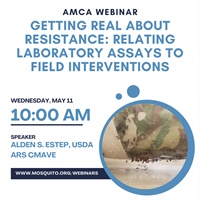Getting Real about Resistance: Relating Laboratory Assays to Field Interventions
- Average Rating:
- 2
- Categories:
- Webinar Archive
- Faculty:
- Alden S. Estep III
- Course Levels:
- All Levels
- Duration:
- 1 Hour Session
- Format:
- Audio and Video
- License:
- Never Expires.
Description
Laboratory insecticide resistance (IR) testing is a critical part of an integrated vector management program and can provide data for operational decision-making and improving efficacy. However, the correlation between IR observed in the laboratory and the threshold at which this IR negatively effects field operations is not clear, thereby limiting the effective use of this information. Innate species-specific differences, as well as differences in the mechanistic contributions to the IR phenotype, modes of action, and the chosen field intervention all play a role in the observed level of IR at the operational level.
Aedes aegypti and Culex quinquefasciatus, the two primary US mosquito vectors, widely show resistance in bottle bioassays and demonstrate these differences. Laboratory characterization and quantification of this resistance shows a range of intensities and very different mechanistic contributions in these species. Operational characterization of these same strains using common formulated products shows that the mechanisms underlying the IR phenotype play a large role in the observed efficacy. High levels of enzymatic activity provide a robust resistance to pyrethroids and significant cross resistance to other modes of action like organophosphates, resulting in reduced field efficacy. In contrast, strong genetic resistance results in more focal resistance to pyrethroids and little resistance to other modes of action. There are demonstrable limits of enzymatic activity and genetic resistance at which the IR exceeds the ability of synergized products to restore efficacy.
Effective operational interventions require a data driven approach that considers the species being targeted, the likely mechanisms involved, and the interventions available to control strong insecticide resistance.
Outline:
- Quick review of good IVM practices
- The current state of IR in Cx. quinquefasciatus and Ae. aegypti
- IR in the lab and mechanism at work
- IR in the field
- Strategies for dealing with strong IR
- In the presence of strong enzymatic resistance
- In the presence of strong genetic resistance
AMCA Members - This archived webinar along with all AMCA webinars is available free to our active members. We are currently syncing this new system with our database to have seamless identification of our members, but until that is finalized you can access all webinars (live and archived) for free using our membership code which can be found in our member portal here.
